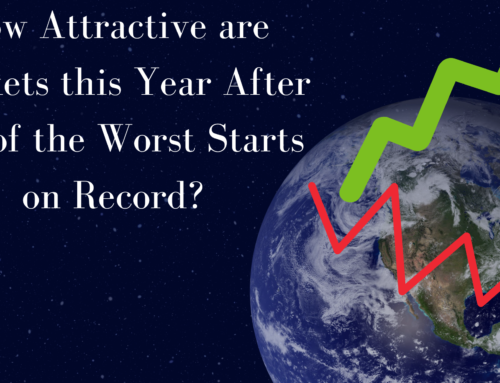In my last post I dispelled the notion of technological unemployment – despite all the hype, it simply can’t be the case that automation is reducing the need for human labor because if it were then we would see a negative correlation between wage growth and GDP growth. In fact, we see the opposite; countries with faster-growing economies continue to have faster-growing wages and higher labor-force participation. Demand for labor, including unskilled labor, is actually quite high right now and it should continue to grow for decades to come (granted it will ebb and flow with the business cycle as it always has).
But I left one question unanswered: why have lower-income Americans seen so little wage-growth compared to higher-income Americans? Since the early 1980s the highest-earning households have significantly outpaced their lower-earning counterparts.
So if it’s not robots, then why is it that income inequality is increasing and the American working class is struggling to keep up? Again, the key to understanding what’s going on lies in the international data. In my last post I looked at the relation between wages and GDP among OECD countries since the turn of the millennium. If we look at those same wage growth figures for OECD countries over the 2000-2017 period it turns out there’s one simple variable that explains half of the variation in outcomes between these countries: whatever their average wage was back in 2000. Specifically, the higher a country’s wages were back in 2000, the slower they grew over the next 17 years. This can be seen by the negative relation between the log of 2000 average wages and subsequent growth rates below.
So basically, countries that already had high wages around the turn of the millennium have had little to no wage growth since then, while lower-income countries have fared much better. In 2000, the United States had the third highest wages in the OECD, just barely behind Switzerland and Luxembourg. We’re still number 4 (Iceland recently pulled ahead of us), but the rest of the developed world has narrowed the gap by a significant degree.
Notice how this pattern in the international data is the opposite of what we saw above with the intranational household income data: while the affluent have pulled ahead of the working class within the US, around the world it’s the lower-income countries that have been growing faster than the high-income countries. Thus far we’ve only looked at OECD data, but this is hardly just a developed-world phenomenon. On the contrary, catch-up growth has been one of the most striking global trends in recent decades. Let’s broaden our horizons now and consider growth around the developed and developing world. Looking at data from the world’s largest 100 economies with full-sample data (this excludes micro-nations that may represent statistical outliers), below I recreate the graph above of income by quintile across countries for the 2000 – 2017 period. Because wage data are not available for many developing economies I use per-capita GDP figures, which we have established have a very high correlation with wages.
We see convergence on every level of the income distribution, a complete reversal of the within-US results we saw above. The richest 20 countries experienced the slowest income growth of any quintile, and the richest 5 countries (which includes the US), had slower growth still. The bottom quintile, on the other hand, nearly quintupled its average per-capita GDP, from a pitiful $401 per year to $1,977. Of course, to American readers, both these numbers sound like crushing poverty, and they often are. That a billion or more people around the world still live on such meager earnings is a sobering reminder of how well we in the developed world have it, even among those in the lower income brackets. But to the average Ethiopian or Laotian or Ukrainian (all members of the bottom 20), the difference between $401 and $1,977 can be literally life or death. Here’s a graph I’ve shared before: the percentage of the world in extreme poverty over time, currently defined by the World Bank as less than $1.90 a day, roughly what it takes to get adequate daily calories from staple crops.
This is the happiest infographic there is, and in my opinion represents mankind’s greatest accomplishment. For most of human history until about 50 years ago, roughly half the world constantly lived on the verge of starvation. Today it’s less than 10% (about 8% according to the latest numbers, or ~635 million people, still too many). Since about 1980 global extreme poverty has been falling rapidly and is now in virtual freefall. Most people alive today will live to see the day that the scourge of hunger is forever wiped off the face of this earth.
But notice that the acceleration of the alleviation of poverty around the world around 1980 roughly corresponds to the time frame that most observers point to as when income inequality in the US and other developed nations started taking off. So here is my hypothesis: income inequality is increasing in the US and other developed countries because poverty is falling everywhere else.
Solow Mojo
This is not an exotic or fringe idea: it’s actually textbook development economics, namely, it’s exactly what we would have predicted under the Solow growth model, a staple of undergraduate economics courses. Basically, under standard economic theory, capital acts like water seeking its lowest level, flowing away from parts of the economy with high capital to labor ratios towards low capital to labor ratios. In other words, rich, developed countries will tend to see net capital outflows towards poor, developing countries, lifting incomes in the latter and slowing them in the former until equilibrium is achieved. Sweeping a lot of details under the rug for now, this is basically the process we have seen take place over the last 30-odd years. As a result, those at the bottom – workers in the developing world – and those at the top – capitalists, executives, and entrepreneurs around the world able to access newly open markets – have seen their fortunes rise at unprecedented rates, while those in the middle – the working classes of the developed world – have experienced relative stagnation. This is hardly a utopia where everybody is made better, but nor is it the dystopia often portrayed in the media where the rich get richer by squeezing the poor out of the last nickel and dime. Economics doesn’t always make for easy storytelling.
There is plenty to feel ambivalent about in our world today. While we should all applaud the rise of the formerly-poor citizens of the developing world into the middle class, most people in the developed world understandably feel concern for the fate of the middle class in their own country, and the politics of the day on both the right and left are a reflection of that fact. There is plenty of room for discussion on what role governments should play in supporting its citizens in this great capital-labor equilibration process known as globalization, but one option that doesn’t help anybody is trying to stop it altogether.
One question to consider with the Solow growth model as it relates to recent world economic history: why now? If the natural tendency is for capital and incomes to equalize across countries, how did we end up with rich countries and poor countries in the first place, and why did it take until 1980 or so for this process of convergence to finally take off?
We know that the industrial revolution kicked off in Britain around 1800 and quickly spread to the rest of “the West”, broadly speaking. But while industrialization caught on in Europe, North America, and a few other places and brought with it capital formation, technological innovation, and steadily rising standards of living, most of the rest of the world was slow to catch on. Economists generally agree that the main reason for this is institutions. Since at least the industrial revolution, the governments of Western nations have mostly been more-or-less liberal, more-or-less democratic, and more-or-less committed to encouraging commerce and industry by protecting private property, enforcing contracts, etc. But for many years most of the rest of the nations of the world lived under communist, fascist, colonial, monarchist, or just simply corrupt and incompetent governments that were not conducive to the capital formation necessary to spur economic growth. But starting in the mid-1970s with the opening up of China, then accelerating with the fall of the Soviet Union, more and more nations around the world started moving towards democracy, liberalism, and capitalism, opening up their markets and inviting Western investors in. We can liken this process to the West having been an isolated bucket with a water level representing capital that was slowly rising, fed from the faucet of technological innovation, for 150+ years. Then, over a relatively short period of time, several valves opened up near the bottom of this bucket leading into several other mostly-empty chambers representing the rest of the world. Water flows out until the other chambers are either filled or their water levels are equal.
How big these chambers are and how fast the water flows is largely determined by how much economic freedom a society has, and this is something that can be measured. In 1995 the Wall Street Journal and the Heritage Foundation created the Index of Economic Freedom, an annual ranking of the nations of the world based on how open and free their markets are. The index uses a quantitative rules-based approach to score each country on several sub-categories of economic freedom such as tax rates, ease of opening a business, judicial independence and transparency, perceptions of corruption, openness to foreign trade and investment, monetary stability, regulatory burden, and so on. The scores are then aggregated into a total score for each country on a 0 – 100 scale. In principle, this measure should capture how conducive a country’s governance is to economic innovation and growth.
When trying to measure something as abstract and multifaceted as economic freedom, one can of course always quibble with this or that detail regarding the underlying methodology, or the over-arching philosophy guiding it, but what I like about the Index of Economic Freedom is that it is an attempt to apply scientific rigor to the area of comparative policy analysis, where the discussion is so often anecdotal and couched in black-and-white, ideological terms. For example, we often hear observers from both sides of the Atlantic and both sides of the political spectrum talk about America being a land of “cowboy capitalism” and “unfettered free markets” whereas the nations of continental Europe practice “democratic socialism.” But when you actually try to systematically compare policy details you see that the reality is a lot messier than this simplistic narrative would suggest. Despite our reputation as the world’s great bastion of capitalism, the United States does not even rank in the top 10 of most economically free nations. In the 2018 edition we come in at #18 with a score of 75.7 out of 100. Above average, for sure, but hardly remarkable. And while the US indeed has a freer market than many European countries like Germany, France, Spain, and Italy, just as you might suspect, there are several others that score higher than us, such as Ireland, the Netherlands, Switzerland, and… wait for it… Sweden. Yes, famously “socialist” Sweden is actually more capitalist than the United States, according to the Wall Street Journal and the conservative-leaning Heritage Foundation, owing to its stronger protection of property rights and judicial effectiveness, monetary stability, lighter business licensing requirements, and greater openness to foreign trade (on the other hand, Sweden has significantly higher taxes and stricter labor regulations; overall they’re all of 0.6 points higher than America). All in all, the US is middling among OECD countries in its degree of economic freedom, and across the world no country is a major outlier (with the possible exception of North Korea); every country blends free markets and government intervention to varying degrees, leading to a fairly continuous distribution where the difference between countries next to each other in rank is hardly noticeable (such as South Korea (score of 73.8) vs. Latvia (score of 73.6)) while the difference between countries on far ends of each other is great (such as Singapore (score of 88.8) vs. Venezuela (score of 25.2)). This makes it very convenient for use in statistical analyses.
What does all this have to do with wage stagnation and income inequality in the US? Basic development economics suggests that an important determinant of wage growth is the free flow of capital – basically, economic freedom. Now, I’ve just shown that theory and evidence agree that poorer countries are growing faster than rich countries as a result of globalization. A temptation among those in rich countries is to say that by “protecting” domestic industry from foreign competition we can stop this leakage and keep all the higher growth for ourselves. But this reasoning is flawed for a couple reasons: for one, while it is relatively easy for governments to prevent foreign goods, capital, and people from flowing in to a nation, it is much harder to prevent it from flowing out, short of Soviet-style despotism. Intelligent, high-skilled, opportunistic people go where the opportunities are, and if governments put too many obstacles in the way of putting their talents to good use and accessing the largest market possible, they may just go somewhere else and take their money with them. “Brain drain” and capital flight are real, important phenomena that shape the wealth of nations in today’s world, and governments that try to stand athwart market realities may simply lose their top talent and their capital stock and end up poorer and more isolated as a result. Secondly, even if you can keep foreign capitalists out and domestic capitalists in, you eventually run into diminishing marginal returns. Adam Smith famously observed that “the division of labour is limited by the extent of the market.” If Albert Einstein, Thomas Edison, Henry Ford, Elon Musk, and Jeff Bezos were all stuck on a desert island together, they’d still just be hunting with spears and bartering with coconuts, because you can’t build an advanced technological civilization with just five people in the middle of nowhere, no matter who they are. By the same token, the smaller your domestic market is in terms of geography and population, the less specialization you can achieve as an economy and the sooner you hit a wall against which further innovation becomes prohibitively expensive. The United States is a large country and this served us well historically as America was effectively the largest “free trade zone” in the world for our first 150 years or so, but we’re still only 5% of the world’s population and today’s most advanced technologies require supply chains that span the globe. We could make smart phones entirely within our borders, but that would require diverting resources away from so many other things that the cost would be so high nobody would buy them. We know this because Argentina tried to do just that exactly and it was a complete disaster.
So economic theory would predict that controlling for the level of wages, greater economic freedom would predict higher wage growth, contra protectionists and economic nationalists who would predict it leads to lower wage growth. What do the data say? If we look at the same OECD wage data from above and run the same regression as before but add each country’s average score on the Index of Economic Freedom over the sample period as another variable in addition to the level of wages in 2000 we get the following results:
When we run the regression, wage growth is still negatively predicted by the level of wages at the start of the sample, but significantly positively predicted by the average level of economic freedom. The t-stat on the economic freedom variable is 3.4, suggesting it is a strong predictor of wage growth and there’s virtually no possibility the relationship is the result of chance. Moving from the one factor model looking at just the level of wages to the two factor model looking at the level of wages and the level of economic freedom we move from being able to explain half of the variation up to two thirds, a very good fit for a complex global socioeconomic phenomenon. In common language, we can explain most of the difference in wage growth around the world by looking at how rich the country was to begin with and how much economic freedom it has, exactly in accordance with basic economic theory.
We can do better yet. For the above analysis I used each country’s average score on the Index of Economic Freedom over the last 18 years. Over that period of time, some countries have undergone reforms to increase their economic freedom, some have become more interventionist and less economically free, and some have bounced around with no clear trend. Intuitively, a pattern of increasing economic freedom should be associated with stronger economic performance, so now I test a three factor model, predicting wage growth based on wage levels, economic freedom levels, and growth in economic freedom over the sample period (which may be positive or negative).
When we run the regression we find that all three variables are statistically significant with each other, with growth in economic freedom being strongly positively associated with higher wage growth (t-stat of 2.9). With all three variables together we can explain nearly three quarters of the variation in the data. Again, this is a very good fit for economic data, and if we broaden our sample once again to data for the whole world using GDP-per-capita data we find qualitatively similar results. In words, the most important factor in explaining wage growth in recent decades has been the level of wages, with low-income nations earnings more money the fastest. Controlling for the level of wages, the most important determinant of growth is the degree to which an economy has a free market, and whether that economic freedom has been improving or deteriorating.
Where does that leave the US? We have experienced relatively stagnant wages in this country for decades, and that fact is well explained by this model. First of all, we started out as a high wage country, so slow wage growth is no surprise for that reason alone. Furthermore, despite our international reputation, the US actually has a relative lack of economic freedom for as rich as we are (the four other countries in the OECD with top 5 wages – Luxembourg, Switzerland, Iceland, and the Netherlands – all have a higher economic freedom score than we do). Finally, and perhaps most depressingly, from 2000 to 2017 the US has had the 4th worst growth of economic freedom in the OECD, one of only 7 countries with a negative growth rate (meaning less freedom than before), ahead of only Spain, Portugal, and Greece. Whereas most developed countries have made reforms since the turn of the millennium to reduce regulatory red tape, open up to global markets, and make it easier for people to start a business and raise capital, the US – under both political parties – has generally moved in the opposite direction on these and other issues over the same time. The people who have lost the most as a result of this national shift away from free markets have been lower-income American workers, whose labor has become more detached from global markets and thus less valuable compared the counterfactual case in which the US more fully embraced it’s reputation as the global leader of the free market.
And so we see that the source of America’s economic funk, the cause of our angst and vitriol is not a result of those bogeymen, robots and globalization. If anything, it’s a lack of robots and globalization that’s to blame. Bring on all the amazing foreign robots!
What a time to be alive!
Disclosures: This post is solely for informational purposes. Past performance is no guarantee of future returns. Investing involves risk and possible loss of principal capital. No advice may be rendered by RHS Financial, LLC unless a client service agreement is in place. Please contact us at your earliest convenience with any questions regarding the content of this post. For actual results that are compared to an index, all material facts relevant to the comparison are disclosed herein and reflect the deduction of advisory fees, brokerage and other commissions and any other expenses paid by RHS Financial, LLC’s clients. An index is a hypothetical portfolio of securities representing a particular market or a segment of it used as indicator of the change in the securities market. Indexes are unmanaged, do not incur fees and expenses and cannot be invested in directly.











